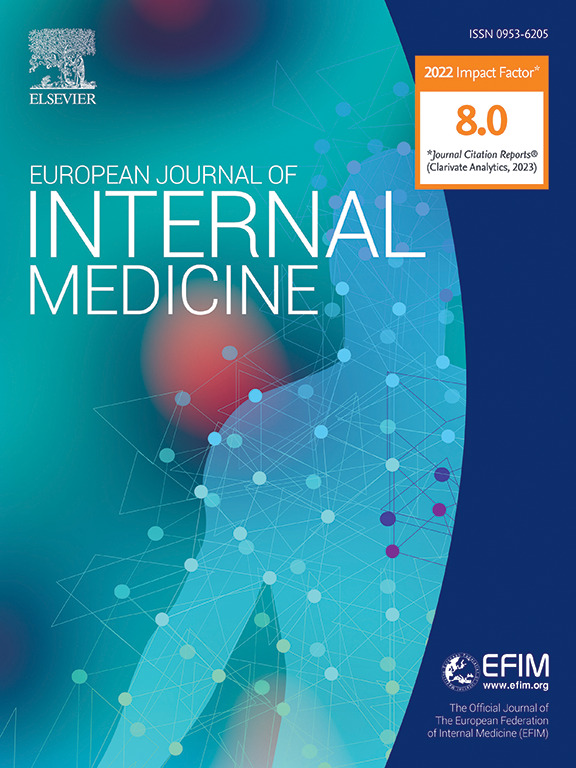Chronic kidney disease classification according to different formulas and impact on adverse outcomes in patients with atrial fibrillation: A report from a prospective observational European registry
IF 5.9
2区 医学
Q1 MEDICINE, GENERAL & INTERNAL
引用次数: 0
Abstract
Background
Chronic kidney disease (CKD) and atrial fibrillation (AF) often coexist, making accurate renal function estimation crucial, typically through equations calculating estimated glomerular filtration rate (eGFR) or creatinine clearance (CrCl).
Objective
To compare the concordance and predictive performance of different renal function estimation equations in a European cohort of AF patients.
Methods
We analyzed data from AF patients enrolled in a prospective observational European registry. Renal function was estimated using eight formulas: BIS-1, CG, CG-BSA, CKD-EPI, EKFC, FAS, LMR and MDRD. Concordance between formulas was assessed using weighted Cohen’s Kappa, while Cox regression and receiver operating characteristic (ROC) curves evaluated their association with outcomes (composite of all-cause death, any coronary revascularization and any thromboembolism).
Results
We included 8,506 patients. CKD-EPI demonstrated good to excellent concordance with other formulas, with the lowest concordance with CG (K = 0.607; 95% CI, 0.595-0.618) and the highest with MDRD (K = 0.880; 95% CI, 0.873-0.887). The risk of adverse outcomes increased sharply when renal function dropped below 60 ml/min across all formulas. CG-BSA and CG formulas showed the best discriminative ability for predicting composite outcomes (AUC 0.660, 95% CI 0.644-0.677, and 0.661, 95% CI 0.644-0.678, respectively). Based on integrated discrimination improvement (IDI) analysis, compared to the CKD-EPI equation, the CG and CG-BSA formulas showed significant improvements in sensitivity of 0.9% and 1.1%, respectively
Conclusion
Equations for estimating renal function vary in concordance, with potential implications for drug prescription and predicting adverse events. CG and CG-BSA formulas showed superior performance in identifying patients at risk for adverse outcomes.
慢性肾脏疾病的分类根据不同的配方和对房颤患者不良结局的影响:一份来自前瞻性观察性欧洲登记的报告
背景:慢性肾脏疾病(CKD)和心房纤颤(AF)经常共存,因此准确的肾功能评估至关重要,通常通过计算估算肾小球滤过率(eGFR)或肌酐清除率(CrCl)的方程。目的:比较欧洲AF患者队列中不同肾功能估计方程的一致性和预测性能。方法:我们分析了前瞻性观察性欧洲登记的房颤患者的数据。肾功能评估采用8个公式:BIS-1、CG、CG- bsa、CKD-EPI、EKFC、FAS、LMR和MDRD。使用加权Cohen’s Kappa评估公式之间的一致性,而Cox回归和受试者工作特征(ROC)曲线评估其与结局(全因死亡、任何冠状动脉血运重建和任何血栓栓塞的组合)的相关性。结果:我们纳入了8506例患者。CKD-EPI与其他公式的一致性较好至极好,与CG的一致性最低(K = 0.607;95% CI, 0.595-0.618), MDRD最高(K = 0.880;95% ci, 0.873-0.887)。在所有配方中,当肾功能低于60 ml/min时,不良后果的风险急剧增加。CG- bsa和CG公式预测综合结果的判别能力最好(AUC分别为0.660,95% CI为0.644-0.677,0.661,95% CI为0.644-0.678)。基于综合判别改进(IDI)分析,与CKD-EPI方程相比,CG和CG- bsa公式的敏感性分别提高了0.9%和1.1%。结论:肾功能评估公式的一致性差异较大,可能对药物处方和不良事件预测有潜在影响。CG和CG- bsa配方在识别有不良结局风险的患者方面表现优异。
本文章由计算机程序翻译,如有差异,请以英文原文为准。
求助全文
约1分钟内获得全文
求助全文
来源期刊
CiteScore
9.60
自引率
6.20%
发文量
364
审稿时长
20 days
期刊介绍:
The European Journal of Internal Medicine serves as the official journal of the European Federation of Internal Medicine and is the primary scientific reference for European academic and non-academic internists. It is dedicated to advancing science and practice in internal medicine across Europe. The journal publishes original articles, editorials, reviews, internal medicine flashcards, and other relevant information in the field. Both translational medicine and clinical studies are emphasized. EJIM aspires to be a leading platform for excellent clinical studies, with a focus on enhancing the quality of healthcare in European hospitals.

 求助内容:
求助内容: 应助结果提醒方式:
应助结果提醒方式:


